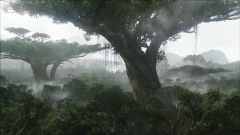The saying “it isn’t rocket science” is a common cliché in English to state, rather sarcastically, that something isn’t that difficult (with the implication that the person complaining about it, well, shouldn’t). But I really think we should change the saying to “it isn’t ecology”, for ecology is perhaps one of the most complex disciplines in science (whereas rocket science is just ‘complicated’). One of our main goals is to predict how ecosystems will respond to change, yet what we’re trying to simplify when predicting is the interactions of millions of species and individuals, all responding to each other and to their outside environment. It becomes quickly evident that we’re dealing with a system of chaos. Rocket science is following recipes in comparison.
Because of this complexity, ecology is a discipline plagued by a lack of generalities. Few, if any, ecological laws exist. However, we do have an abundance of rules of thumb that mostly apply in most systems. I’ve written about a few of them here on ConservationBytes.com, such as the effect of habitat patch size on species diversity, the importance of predators for maintaining ecosystem stability, and that low genetic diversity doesn’t exactly help your chances of persisting. Another big one is, of course, that in an era of rapid change, big things tend to (but not always – there’s that lovely complexity again) drop off the perch before smaller things do.
The prevailing wisdom is that big species have slower life history rates (reproduction, age at first breeding, growth, etc.), and so cannot replace themselves fast enough when the pace of their environment’s change is too high. Small, rapidly reproducing species, on the other hand, can compensate for higher mortality rates and hold on (better) through the disturbance.
Ask any fisher about it. The first (and perhaps best) predictor of a problem in an exploited stock of fish is when the average size starts to drop. When you see the big ones become rarer, you know that your mortality source is picking off the big ones by preference. Usually this also means that the best reproducers are being taken out of the system, so recruitment goes down too. We’ve even seen this effect in the world’s largest fish (whale sharks).
So how many readers up until now had ‘animals’ in the mind’s eye? Probably most of you. It turns out that plants, and in particular, trees, follow the same general rule. So this week I report (a little belatedly, I’ll admit) a clever Perspective that just came out in Science by my good friend and colleague, Bill Laurance (along with David Lindenmayer and Jerry Franklin). Spawned by Bill’s article in New Scientist earlier this year, the Perspective reports the nearly global trend of large trees disappearing – from the jungles of the Amazon to the wet eucalypt forests of southern Australia.
Of course, selective logging has historically taken out the biggest trees first (much like fisheries have done to big fish), and from Bill’s earlier work we know that fragmentation hits big trees the hardest, but it’s actually more complex than that. As the climate warms, increasing frequencies of drought means that the big fellas have a hard time drawing the necessary volume of water up to their canopy leaves, giving rise to leaf loss and eventual death of the individual tree. Also, increasing invasion of things like opportunistic lianas and lantantas prevent recruitment of tree seedlings on the forest floor. Diseases are also hitting big trees the hardest, as are outbreaks of tree-eating insects like the mountain pine beetle in western North America.
So, like the Home Tree of Pandora that succumbed to the greed of extra-planetary humans, the species dependent on large trees the world over are also losing ground. If we lose the biggest of the forest, we’ll lose countless other species. This is just another sad chapter in the synergistic loss of life on Earth.




[…] the old saying goes: “It’s not rocket science”. I think instead that we should be saying “It isn’t ecology” when we are sarcastically referrin… (i.e., not complex) […]
LikeLike
Something that might buck this trend (for large charismatic fauna at least) is our propensity to pour disproportionate funds into the conservation of larger species. It is likely that quite a number of species will be conserved simply because they ARE big – at a huge opportunity cost for smaller, less charismatic species.
LikeLike
I’m not so sure that’s true for most species. We certainly do invest far too much on the cute, charismatic and impressive, but very little on the functionally important large species (sharks, trees, kelp). Even when we try to save a few pandas (for example), there are still far too few of them to ensure persistence, and one can argue that many of these species are functionally redundant.
LikeLike
This is all rather worrying, but even more so when one considers our collective inability to accurately measure size in the wild, both for animals and plants. I see a major challenge in ecology and one that deserves increased attention, as the accurate and repeatable measurement of size(in whatever form) of adequate samples of individuals. So often our conclusions are based on mean and median sizes within populations but the data that these are based on are often inadequate. Something to ponder….
LikeLike
Agreed. Any serious ecologist will tell you that means are irrelevant – it’s the variance (and extremes) that drive system dynamics.
LikeLike